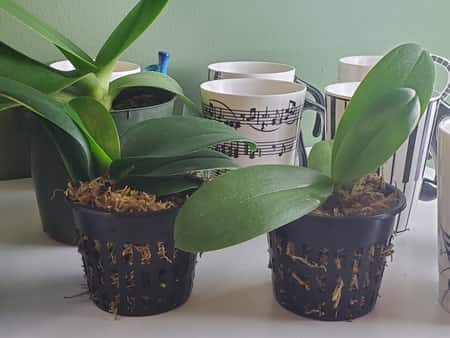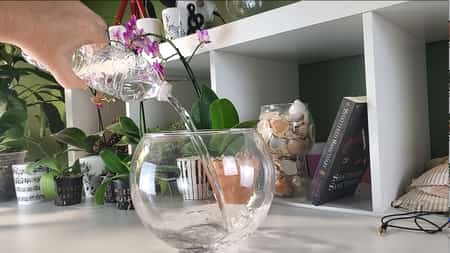Most orchids thrive in humid environments and high humidity is part of growing them indoors. But what do you do if your office space or living room is dryer than the counties in Nevada? You have two options: purchase desert orchids (or dry climate orchids), or adapt your environment to adjust to the humidity-loving orchid.

1) Purchase Desert Orchids Which Thrive in Spaces that Lack Humidity
You might be wondering about the title: desert orchids. Can orchids grow naturally in the desert? They can, and do.
The first option is to purchase orchids that love dry conditions. It’s easy to think of orchids growing in lush, subtropical rainforest like the Amazon, clenching to the tree bark as they receive filtered sunlight through the canopy of leaves.
It’s harder to imagine orchids in the desert—really hard. Nevertheless, desert orchids do exist. They thrive in conditions that would be detrimental to most orchids, yet these desert orchids have found a way to make the best of the conditions they were given.
If you live in arid, dry climates, with extremely hot days and nights that can drop significantly, don’t give up hope. To grow orchids in a dry climate (either indoors or out), you’ll need to focus on mainly three things: humidity, lighting, and proper watering.
You’ll need to select orchids that will thrive in that climate, like several species of:
Corallorhiza,
Eulophia petersii,
the steam orchid (Epipactis gigantea),
Listera,
and Platanthera.
2. Purchase Humidity Tolerant Orchids
and Adapt Your Environment
I have to admit that those orchids aren’t what comes to mind when someone initially thinks of orchids. So, if you have your heart set on growing orchids like Phalaenopsis, Cattleya, Dendrobium, or Oncidiums, in a dry climate, then don’t give up.
You can grow orchids indoors even if you live in the desert-like climates, focusing on specific areas that will aid the cultivation process. Adapt your indoor environment to better acclimate orchids that don’t thrive in the desert. To do this, you’ll need to make changes to the way to water and maintain humidity, which brings us to the second option mentioned earlier.  (Source)
(Source)
2A. Increase Humidity
First, you’ll need to check your natural humidity setting indoors. Most households range around 33% relative humidity (rH) but can drop drastically if you have a full-time air conditioner or heater running. Both these appliances suck the humidity out of the air, dropping levels to around 27%. Office spaces tend to be worse (lower).
To do this you can buy an inexpensive humidity gage, which are usually under 10 US dollars. These are good to have as beginners, since it’s hard to know what the right humidity level should be.
You’ll get used to what the right humidity level feels like (you can smell the humidity in the air and feel it on your skin). Then the gauge isn’t as important anymore.
Once you know where you’re starting point is, you need to know where you’re aimed.
Secondly, check how much humidity each orchid likes to live in. You’ll have to raise the humidity levels to best recreate that environment.
For example, Phalaenopsis like to have 50 to 60% rH. To achieve this, you’ll most definitely need a humidifier. Don’t forget that these are the genera of the orchids, and inside each genus there are tons of species. Some can be drastically different than others. Gather your orchids full ID, with genera and species, and research what growing conditions it likes to live in.
Humidity Levels for Most Common Orchid Genera
Phalaenopsis 50 to 60%
Cattleya 50 to 70%
Dendrobium 50 to 60%
Oncidium 50 to 70%
Cymbidium 40 to 60%
Vanda 60 to 80%
Tip: Most new orchid growers like to place their orchids in the bathroom, because of high humidity. I personally don’t recommend this because even though the humidity is high, it’s not constant.
Think about how many times the shower is in use a day. Let’s say with a household of 4 people, you’ll have four showers a day. So… four times a day the humidity will raise to 100% for about 10-15 minutes. Then it drops to 27% for the next 23 hours. Humid. Dry. Humid. Dry. Humid. Dry… Poor orchid.
How to Raise Humidity in Dry Climates
(Like Indoor Offices)
If you don’t have a humidifier, this article on the 5 best types of humidifiers points out what you need to look for when purchasing a humidifier and gives some tips on buying one that fits your needs.
Humidity trays are also an essential, if your orchid sits in an office environment. You can easily make one by using household gadgets, like marbles, pebbles, and even seashells work. Place them in a wide bowl and fill the bowl half-way with water. Don’t let the bottom of the pot sit in water, since the roots will rot.
The humidity on the pebbles evaporates upward, so the bottom of the orchid leaves remains a bit more humid during the day. Let me warn you though: humidity trays will only raise the levels about 3%. It’s a tiny improvement, but 3 is better than none.
If your still having problems keeping the humidity up, you can group plants together.
Instead of keeping your orchids spread out through the house, group them all into one big collection. This also helps if you have ferns, since they aid in raising humidity levels around them. (Source)
Misting the entire room in the early morning is another way to raise the indoor humidity, except the results won’t last more than a couple hours at most.
Air roots are the most susceptible to drying out, so lay a thin, airy layer of sphagnum moss over the top of the medium. This is called a top layer, and will help the orchids; areal roots not dry out as much. Just don’t place the sphagnum near the crown or stem of the orchid.

If you’re feeling extremely creative, go for the terrarium look.
This will require some more research and lots more information, but making a closed terrarium is not a bad idea if you have your orchids in an office space like I do.
You can keep a small humidifier by your orchid and turn it on a few times a day if you want to isolate it form the rest of your orchid collection.
2B. In Dry Climates, Proper Watering Ensures the Orchids are Hydrated (WATERED PROPERLY)
We’ve covered humidity, and now we’re on to the second part of dry climates and indoor orchids: watering. You might think that watering and humidity are the same thing in one. They aren’t. Air needs to be humid on the leaves, independent of how much water these plants get on their roots.
For example, Cymbidiums like to have the humidity in the air always high, but they are also water-loving plants. They prefer to have their roots a bit moist all the time. Moist is not soggy. Cymbidiums, being slightly terrestrial, thrive next to rivers, streams, and waterfalls.
Water is constantly brushing up against the rocks near where they’re planted, and the roots are moist most of the time.
On the other hand, Phalaenopsis are also higher humidity lovers (not as high as some, but still high…), but prefer to have a significant period of drying out for their roots. They live on the top of tree niches, where air currents are strong. The wind dries out the roots before it torrentially rains again.
In both these examples, the orchids love high humidity, but watering habits change and vary widely for them. You’ll need to do some research on your specific orchid to see how to water it (and how not to).
Let me add my two cents in here: there is a TON of misinformation about watering orchids, especially when it comes to ice cubes. This is my soft spot when it comes to orchids and I really get upset when the advice to water with ice cubes comes up.
To control my anger issues, 😊 I’ve written an article specifically on watering orchids, and if you’ve ever thought about what type of water to use (hard water, soft water, distilled water, reverse osmosis, high pH, low pH, etc) it might be worth checking out.
Why is watering important? Isn’t high humidity enough?
You’ll need to water a little longer than you normally do for more humid climates. Don’t drench the poor potting medium until it’s unbearably soggy, but maintain water for a longer period of time.
The extra-dry climate will dry out the orchid sooner and roots will become dry and crunchy—especially aerial roots. Just because humidity is covered the roots will dry out faster. Avoid terra cota pots, since they promote rapid evaporation. Plastic pots are much better.
Don’t Stop Learning!
If you want to be included in more information and get a 14-page fertilization guide, please sign up for my newsletter. I don’t spam, but send emails out bi-monthly with some curious topics of interest. If you want more information, click here to go to a specific page on this website where I explain it more in detail.

Also, if you are looking for an orchid journal to keep your notes specifically about orchid care, check out my 2 solutions for that on this page. If note-keeping isn’t your thing, then there is a free excel spreadsheet that you can download. Click here for more information on how to do that.
If you subscribe to my newsletter, I will send you a 14-page guide on the main tips of orchid fertilizer. It is downloadable and you can print it out on your computer. I designed the guide to double up as a coloring book, just to make it fun.
If you follow these tips on keeping humidity high and watering a little more each time, then your orchids should be able to adapt well in a big office space, or in an overly dry living room.
Happy Cultivating!

